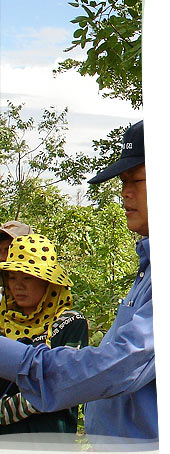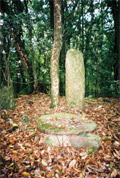

Community Forestry International Programs
Fri, Oct 19 2007
|
COMMUNITIES, CULTURE, & CONSERVATION
Many nations have made great progress over the past thirty years in establishing national park networks to protect natural ecosystems. Often these areas include endangered animals such as orangutan, elephants, rhinoceros, gibbons, tigers, leopards, and other “megafauna.” Yet as the world’s population has grown, the mere designation of national park status alone has not resulted in effective protection. Research has demonstrated that when local communities are involved in park protection and management, communities are demonstrating an effective capacity to maintain park trails, monitor wildlife populations, alert park wardens to poaching activities, and guide and educate visitors regarding wildlife behavior. CFI supports the active involvement of rural communities in the management of national parks. CFI creates opportunities for interested communities to work with park managers to enhance forest and animal conservation, strengthen wildlife monitoring, control poaching, and reduce fire danger. The CFI strategy works with government park managers, international conservation projects, and local communities to establish management dialogues to allow for ongoing cooperation, creating community-patrolled buffer zones, and monitoring systems. By providing human, material, and financial resources to national park settings, wildlife management systems can be greatly strengthened. |
© 2007 Community Forestry International - Forest Rights are Human Rights
Lake Tahoe Web Design by JoeContiCreations.com
Medical Equipment
 Community protection of forests and wetlands with their essential animal habits has a long and ancient tradition. Wild and domestic animal populations have always been an integral part of the daily life of rural families. The importance and respect with which many people have perceived the birds, reptiles, and mammals that surrounded them is reflected in their values and belief systems including both animistic and spirit-based religions as well as the major world religions of Christianity, Judaism, Buddhism, Hinduism, and Islam. Traditions and values that support the conservation of animals and their habitat are a tremendous tool for promoting the protection of threatened species and ecosystems. Community Forestry International (CFI) utilizes this “cultural capital or asset” to achieve environmental and wildlife protection goals.
Community protection of forests and wetlands with their essential animal habits has a long and ancient tradition. Wild and domestic animal populations have always been an integral part of the daily life of rural families. The importance and respect with which many people have perceived the birds, reptiles, and mammals that surrounded them is reflected in their values and belief systems including both animistic and spirit-based religions as well as the major world religions of Christianity, Judaism, Buddhism, Hinduism, and Islam. Traditions and values that support the conservation of animals and their habitat are a tremendous tool for promoting the protection of threatened species and ecosystems. Community Forestry International (CFI) utilizes this “cultural capital or asset” to achieve environmental and wildlife protection goals.